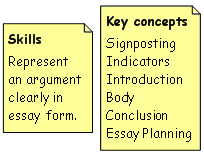The Science Of Scientific Writing Set 5 Set 5-Essays • Second page • Third page • Ordering ideas • Exercise 1 • Signposting • Exercise 2 • Final.
OVERVIEW: The way to well-written science
PART I: Paragraphs and Sentences
SET A: Paragraphs: The Maps Behind Them
SET B: Paragraphs: Using Maps to Meet Readers' Expectations
SET C: Paragraphs with Something Extra: Points and Tails
SET D: The Generic Section: Expectations and Maps as Blueprints
SET E: Scientific Sections: The Methods and Results
SET F: Scientific Sections: The Discussion
SET G : Scientific Sections: The Introduction
SET H : Sentences
SET I : The Paper as a Whole
PART II: The Paper and its Sections
SET 1: Argument Parts
SET 2: Indicator Words
SET 4: Locating Arguments in Prose
SET 5: Rationale's Essay Planner
SET 6: Evidence in Arguments: Basis Boxes
Synthesis 1: Position-Early Paragraphs
Synthesis 2: Position-Final Paragraphs
Synthesis 3: Writing a Discussion I
Synthesis 4: Writing a Discussion II
Set 5 - Rationale's Essay Planner
Rationale™ has an inbuilt essay planner - or generator. This tool can help you learn some very elementary writing strategies.
The essay planner gives each item box (reason/claim/objection) equal weight when it generates text. In later weeks, we will learn how to evaluate the various sub-sections of a map, and we will assign each box a value that indicate its argumentative strength. When we come to write up texts later in the course, we will use these indices of relative argumentative strength as guides to how much we will emphasise any given sub-section.
The essay generator will NOT create text suitable for publication, but it WILL help you to understand the more sophisticated map-to-text strategies we employ later in the course.

Content of this page drawn in whole or part from the Austhink Rationale Exercises with permission from Austhink.